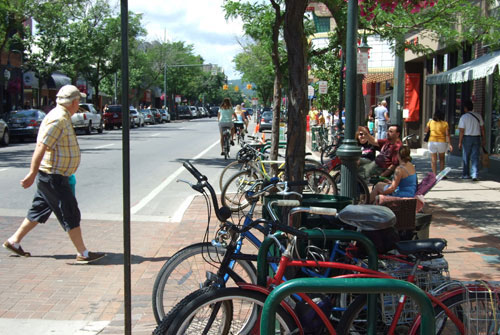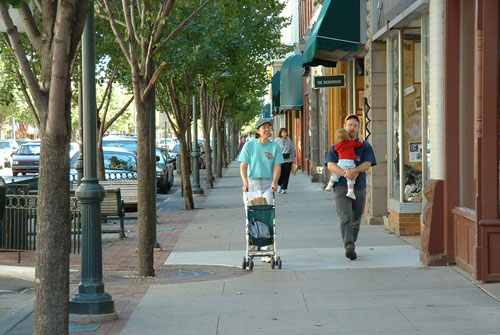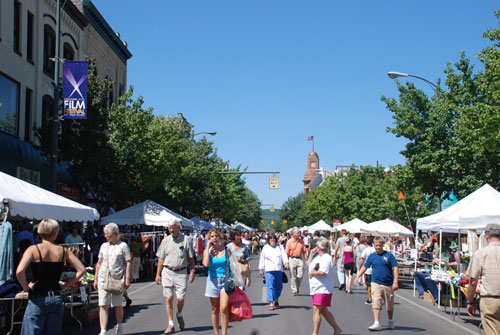Front Street: Traverse City, Michigan

Summary
Front Street is one of best — if not the very best — place to be in this popular northern Michigan resort community. The street captures just about everything residents and visitors like about Traverse City: scenic views of the Boardman River, a Victorian-era opera house, the Jay Smith Walkway pocket park, generous 12-to-14-foot-wide sidewalks with benches and shade trees, the city's highest density of stores and businesses, and numerous festivals and special events that attract hundreds of thousands of people each year.
Designated Area
Designated area is three long blocks between Union Street to the west and Boardman Street to the east.

Front Street functions as a 'complete street' by accommodating all users equally well. These bike racks were installed on 8-foot curb bump-outs that narrow the roadway and help to slow traffic. Photo courtesy of City of Traverse City.
Planning Excellence
The city opera house was placed on the National Register of Historic Places in 1972. In the mid-1970s the city installed the first curb bump outs followed by 1990 streetscape enhancements that included low-level lighting, brick pedestrian crosswalks, and new Bradford pear and ash trees.
A new parking structure — located on a remediated brownfield — has ground-floor retail space.
Other changes involved painting a separate bike lane and limiting driveway access so Front Street is a "complete street" that accommodates motorized and non-motorized users equally well.

Trees, awnings, wide sidewalks, and benches add to the welcoming pedestrian atmosphere along Front Street. Photo courtesy of City of Traverse City.
Defining Characteristics, Features
Complete Street
Three traffic lanes: two for automobiles, one for bicyclists
- Twelve- to 14-foot wide sidewalks; brick pedestrian crosswalks at end of each block and four midblock crossings; 8-foot bumpouts calm traffic and improve pedestrian safety; city ordinance restricts driveway access to street
- Larry C. Harding parking deck (2003) set back from street to accommodate retail buildings; parking facility has one of the few driveways to access Front Street
- No parking requirements for businesses; private parking lots prohibited in most cases to reduce area downtown set aside for parking; public transit stops
- Regional trail system extends through downtown and connects to Front Street
Public and Natural Space
- Front Street accessible to Boardman River ; between buildings and at intersections are views of the river and Lake Michigan's West Arm of Grand Traverse Bay
- Jay Smith Walkway pocket park on Front Street; includes plants and trees, benches, and a fountain where children play; provides place to sit, relax, people watch
- Front Street easily accessible to nearby historic residential neighborhoods, Boardman River, Clinch Park and Zoo, Sunset Park, Legion Park, F and M Park, Lake Michigan waterfront
Historic Preservation and Smart Growth
- Historic Districts Commission must approve building permits for development in historic districts, including changes to existing buildings
- Historical renovation has taken place by private donations and public funding generated through tax increment financing; during past 30 years more than $8.5 million worth of restoration taken place
- City Opera House (1891), a beautiful restored Victorian building located at 112 ½ East Front Street, added to the National Register of Historic Places in 1972; the oldest of three such Victorian opera houses in Michigan
- Zoning allows an extra story for downtown buildings that designate at least 20 percent of space for residential uses; encourages mixed uses and that buildings be built to human scale (no more than six stories tall with residential use bonus)
- Regional non-motorized trail system runs through downtown and a bike lane is provided on the side of two streets in the downtown area

Home to several festivals throughout the year, Front Street closes to car traffic during the city's National Cherry Festival that draws nearly a half-million people each July. Photo courtesy of Traverse City Development Authority.
Ongoing Planning Commitment
- Perry Hannah founded Traverse City and plats Front Street in 1852; until 1864, Traverse City only accessible by water
- First brick paving in 1905; street widened in 1945
- Tax increment financing plan adopted in 1997; helps fund capital and infrastructure improvements along Front Street and elsewhere in city
- Downtown Development Authority leads redevelopment efforts downtown and is funded through property tax levy; partners with Downtown Traverse City Association
Community Living Room
- Location for historic, week-long National Cherry Festival each July (begun 1926); attracts half-million people; contributes more than $26 million to economy each year
- Downtown Traverse City Association organizes monthly major event on Front Street
- Other special events on Front Street include bi-annual Art Walk, Traverse City Culinary Tour and the Traverse City Film Festival


